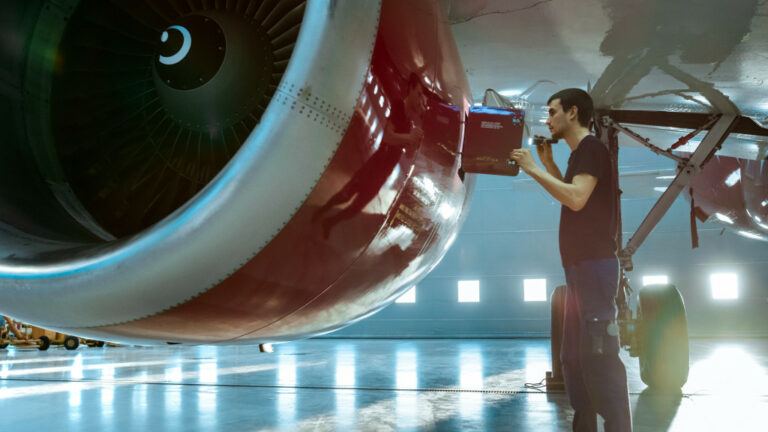Keeping an aircraft in good working order is essential to the aviation industry. Not only does it ensure the safety of everyone on board, but it also helps to avoid costly delays and cancellations. That’s why investing in efficient aircraft maintenance practices is so important.
There have been some major advancements in aircraft maintenance technologies in recent years. From 3D-printed parts to augmented reality, these innovations are making it easier and faster to keep planes in tip-top shape. Here are some of the most promising recent innovations in aircraft maintenance:
1. 3D-Printed Parts
One of the biggest challenges in aircraft maintenance is sourcing replacement parts. Not only do you have to find the right part, but you also have to wait for it to be delivered — which can take days or even weeks. 3D printing offers a solution to this problem by allowing replacement parts to be produced on demand.
For example, if an engine part on a plane breaks, the airline or company will be able to quickly print a replacement using a 3D printer. This will save them days of downtime and avoid the need to cancel any flights.
3D-printed parts are also much cheaper than traditional parts, so they offer a more cost-effective solution for airlines. This is because there’s no need to pay for the molds or tooling required to manufacture parts.
2. Augmented Reality
Augmented reality (AR) is used more frequently in aircraft maintenance. AR headsets allow engineers to see digital information superimposed over their real-world view. This information can include things like wiring diagrams and service manuals.
Using AR, engineers can work more quickly and accurately, making tasks that would normally take hours to take just minutes instead. For instance, an engineer might use AR to quickly find and fix a wiring issue. This not only saves time but can also help to avoid potential mistakes.
AR is still in its early stages of development, but it shows a lot of promise for the future of aircraft maintenance. This is because it has the potential to greatly improve efficiency and accuracy while reducing costs.
3. Enhanced Engine Mounts
Another innovation that’s making aircraft maintenance more efficient is the development of durable aircraft engine mounts. These mounts are designed to be long-lasting, which means they don’t need to be replaced as often.
This is a major advantage because it reduces the amount of time required for engine maintenance. It also helps to avoid potential disruptions caused by replacing engine mounts.
Enhanced engine mounts are made from high-strength materials that can withstand the rigors of constant use. They’re also designed to be more vibration-resistant, which helps to extend their lifespan.

4. Predictive Maintenance
Predictive maintenance is a new approach that uses data analytics to predict when equipment is likely to fail. By identifying potential issues before they occur, preventive measures can be taken to avoid downtime. This helps to improve equipment reliability and reduces maintenance costs.
For example, if predictive maintenance detects that a plane’s engine is likely to fail, the airline can take steps to fix the issue before it causes any problems. This could involve replacing parts or performing scheduled maintenance.
Predictive maintenance is still in its early stages, but it has great potential to improve aircraft maintenance efficiency. As more data is collected, it will become more accurate, making it an invaluable tool for keeping planes running smoothly.
5. Blockchain
Blockchain is a distributed database technology that offers a secure way to track and share data. In the aviation industry, blockchain is being used to track aircraft parts and components throughout their lifecycle. This helps to ensure that only approved parts are used in repairs and that all maintenance records are accurate and up-to-date.
For instance, when an aircraft part is replaced, the blockchain can be used to track when it was installed and by whom. This information can then be shared with other airlines or maintenance providers, so they can be sure that the part is safe to use.
Blockchain also offers a secure way to store data, so it can’t be altered or tampered with. This is important for maintaining the accuracy of maintenance records. It also has the potential to revolutionize aircraft maintenance. Tracking parts and components can help to ensure that only approved parts are used in repairs.
6. Robotics
Robots are increasingly being used for dull, dirty, or dangerous tasks in aircraft maintenance. For example, robots can be used for cleaning engine intakes or inspecting fuselages for damage. Using robots helps to improve safety while also reducing costs and turnaround times.
One type of robot that’s being used for aircraft maintenance is the collaborative robot, or “cobot.” Cobots are designed to work safely alongside humans. This makes them ideal for tasks such as engine assembly, where they can assist workers by performing repetitive tasks.
Cobots are also becoming increasingly popular for inspection tasks. They can be equipped with high-resolution cameras and sensors that allow them to detect even the smallest defects. This helps to improve safety and reduce the need for manual inspection.
In the future, robots are likely to play an even bigger role in aircraft maintenance. As they become more advanced, they’ll be able to take on more complex tasks. This will help to improve efficiency and reduce costs even further.
Investing in efficient aircraft maintenance practices is essential for the aviation industry. Thanks to recent advances in technology, there are now many ways to make aircraft maintenance more efficient — from 3D printing replacement parts on demand to using predictive analytics to identify potential issues before they occur. By investing in these new technologies, planes are kept safe and running smoothly — with minimal delays and disruptions caused by downtime.




